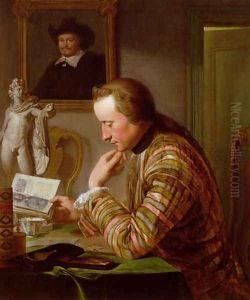Jan Maurits Quinckhardt Paintings
Jan Maurits Quinckhardt was a Dutch painter born in 1688 in Rees, a small town in the Duchy of Cleves, which at the time was a territory of Brandenburg-Prussia, but today is located in North Rhine-Westphalia, Germany. Quinckhardt is primarily known for his portraits, which were highly regarded for their meticulous detail and the lifelike representation of his subjects.
In the early part of his career, Quinckhardt was influenced by the works of Godfrey Kneller, a leading portraitist in England, under whom he is thought to have studied. He spent time in England to hone his craft before eventually moving to the Dutch Republic, where he would establish his reputation as a portrait artist.
Quinckhardt's work was characterized by a strong attention to texture and fabric, as well as a sensitive rendering of the human face. He was skilled in capturing the character and social status of his sitters, often portraying them in lavish attire indicative of their wealth and position in society. His portraits often included intricate lace and fine textiles, which were painted with precision and care, demonstrating his attention to detail and his ability to render different materials convincingly.
Throughout his career, Quinckhardt received commissions from notable figures of his time, and his portraits were sought after by the aristocracy and the bourgeoisie alike. He became a member of the Amsterdam Guild of St. Luke, an association of painters, which further cemented his status as an artist of note.
Jan Maurits Quinckhardt continued to paint until his later years, leaving behind a significant body of work that contributes to our understanding of 18th-century portraiture. He died in 1772 in Amsterdam, leaving a legacy as a master portraitist who captured the likeness and spirit of his subjects with elegance and technical skill.
